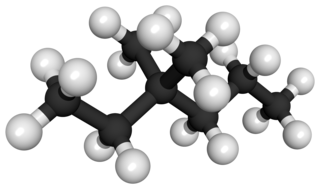
Prednisolone acetate is a synthetic glucocorticoid corticosteroid and a corticosteroid ester. It is the 21-acetate ester of prednisolone.

Mercury(II) cyanide, also known as mercuric cyanide, is a poisonous compound of mercury and cyanide. It is an odorless, toxic white powder. It is highly soluble in polar solvents such as water, alcohol, and ammonia; slightly soluble in ether; and insoluble in benzene and other hydrophobic solvents.

Molybdopterins are a class of cofactors found in most molybdenum-containing and all tungsten-containing enzymes. Synonyms for molybdopterin are: MPT and pyranopterin-dithiolate. The nomenclature for this biomolecule can be confusing: Molybdopterin itself contains no molybdenum; rather, this is the name of the ligand that will bind the active metal. After molybdopterin is eventually complexed with molybdenum, the complete ligand is usually called molybdenum cofactor.

Mercury(II) sulfate, commonly called mercuric sulfate, is the chemical compound HgSO4. It is an odorless salt that forms white granules or crystalline powder. In water, it separates into an insoluble basic sulfate with a yellow color and sulfuric acid.
Isonicotinamide (pyridine-4-carboxamide) is the amide form of isonicotinic acid. It is an isomer of nicotinamide, which has the carboxamide group in the 3-position.
This page provides supplementary chemical data on diphenylamine.

2-Chlorobenzoic acid is an organic compound with the formula ClC6H4CO2H. It is one of three isomeric chlorobenzoic acids, the one that is the strongest acid. This white solid is used as a precursor to a variety of drugs, food additives, and dyes.

1,3-Thiazepine is a thiazepine, which is a seven-membered heterocyclic chemical compound containing nitrogen and carbon.

Xylonic acid is a sugar acid that can be obtained by oxidation of the hemiacetal/aldehyde group of xylose. The C-2 epimer is known as lyxonic acid.

Demeton, sold as an amber oily liquid with a sulphur like odour under the name Systox, is an organophosphate derivative causing irritability and shortness of breath to individuals repeatedly exposed. It was used as a phosphorothioate insecticide and acaricide and has the chemical formula C8H19O3PS2. Although it was previously used as an insecticide, it is now largely obsolete due to its relatively high toxicity to humans. Demeton consists of two components, demeton-S and demeton-O in a ratio of approximately 2:1 respectively. The chemical structure of demeton is closely related to military nerve agents such as VX and a derivative with one of the ethoxy groups replaced by methyl was investigated by both the US and Soviet chemical-weapons programs under the names V.sub.X and GD-7.

In chemistry, methanetetracarboxylate is a tetravalent anion with formula C5O4−8 or C(−CO−2)4. It has four carboxylate groups attached to a central carbon atom; so it has the same carbon backbone as neopentane. It is an oxocarbon anion, that is, consists only of carbon and oxygen.
Mercury(I) oxide, also known as mercurous oxide, is an inorganic metal oxide with the chemical formula Hg2O.

Nupharamine is an alkaloid found in Nuphar japonica and in castoreum.

Bitartrate is an anion which is the conjugate base of tartaric acid. It may also refer to any salt or monoester of tartaric acid.

A dibromoanthracene is a derivative of anthracene with two bromine atoms. All compounds have the formula C14H8Br2. They are all isomers of one another.

3,3-Dimethylhexane is a colourless, odourless liquid, chemical compound in the family of hydrocarbons which has a formula of C8H18. It is an isomer of octane, where two methylene hydrogens at the third position in a hexane molecule have been replaced with two methyl groups.

EA-1763, O-PPVX, V1 or propyl S-2-diisopropylaminoethylmethylphosphonothiolate, is a military-grade neurotoxic organophosphonate nerve agent related to VX. It is part of the V-series. The substitution of a proton for methyl makes its properties more similar to those of VX.














